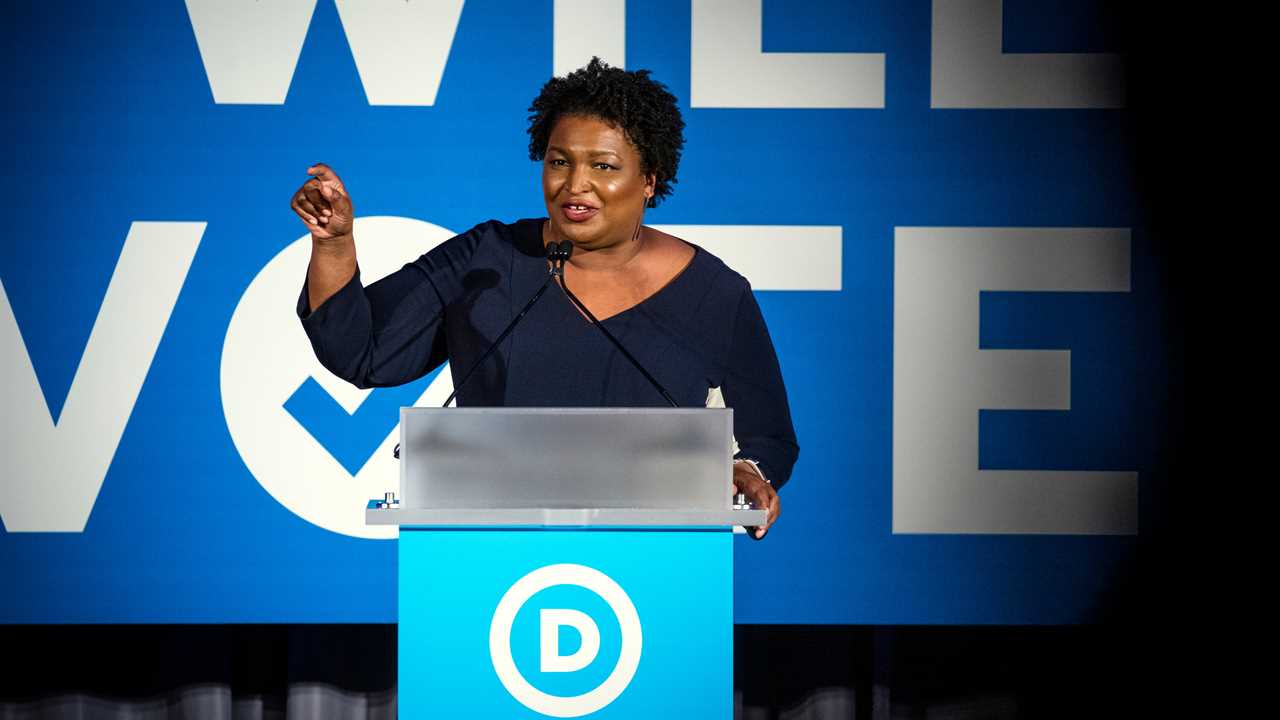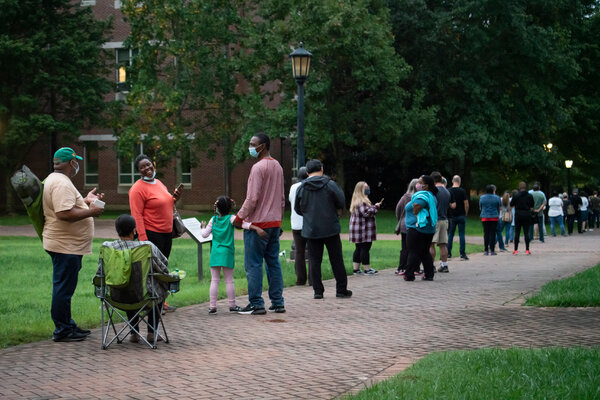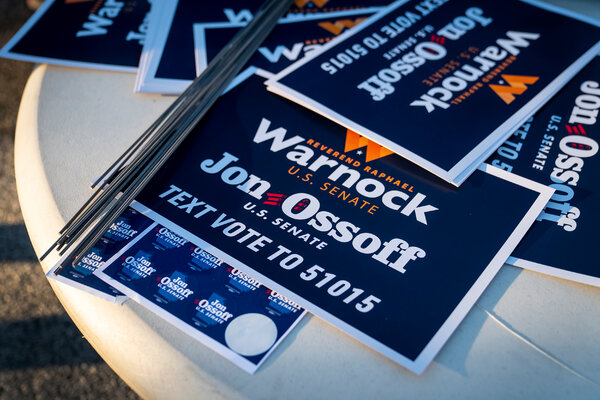
After years of close calls, red herrings, and electoral margins that grew closer and closer, Democrats won Georgia in this year’s presidential election for the first time since 1992.
The win broke the Republican lock on Southern states in the Electoral College, but it also vindicated Stacey Abrams, the Georgia Democrat and former House Minority Leader who has become synonymous with the party’s attempts to win statewide. Ms. Abrams, who has helped start organizations to register new voters and combat voter suppression, said the win was a personal relief — a political bounce back after she narrowly lost her race for governor in 2018.
In an interview with The Times, she outlined how she believes Mr. Biden won and how liberal groups in other Southern states can replicate Georgia’s path. She also weighed in on the current divisions within the Democratic Party, and her future political plans.
These are edited excerpts from the conversation.
Georgia turns blue after all these decades of work. How did you feel when that became clear? Was it vindication? Was it relief? What was the emotion?
I think it was a combination of relief and excitement about what this means. But also a healthy dose of realism — we’ve got this done, but it was narrowly achieved, which means more work remains to be done.
I wouldn’t say vindication in the sense that there was some sort of chest beating, but I am excited about how it proves the model of building this tapestry of leaders across racial and geographic lines. I’ve been privileged to be part of building the resources and the infrastructure and the narratives, that help pull together different communities, all of us working toward the same goal. Over the course of a decade, and with resources, that brought success to fruition.
What was different about the electorate in the coalition this time? What happened in 2020 that in 2018 or 2016 wasn’t able to get done?
Well, I think there’s two pieces to this. One is that demographic changes are ongoing, and every cycle is an opportunity to not only register them but to engage them. So you build the muscle memory of voting, you build the capacity to engage, because people have more information and have a deeper sense of their capacity and their potential as voters.
I would draw a distinction between 2016 and 2020, using 2018 as the marker, because what happened, also, was that we were able to remove remarkable restrictions to voter access.
Voter suppression was very much instrumental in shaping turnout numbers in 2018, and 2016. In 2018, we did much deeper investment in actual voter turnout, but we still ran into the buzz saw of voter purges, exact match closures, old machines that were inaccurately and disparately deployed, broken machines, and then super high rejection rates, comparatively speaking, of Black and brown voters in the absentee or provisional ballots space.
So what we were able to identify — in the concrete ways in 2018 — we were able then to mitigate heading into 2020.
And so I think you see the combination of increased voter engagement through another 800,000 people being registered and staying on the rolls through November 2018 through this election. But you also had the removal and mitigation of a number of barriers that blocked access to the polls.
I think it’s really important, as much as people are excited about the proactive work that we were able to do to bring voters to the polls, we cannot ignore the incredible change that was wrought because voters were actually able to make it through the gauntlet and get their votes counted.

What were those early years like? Were you believed when you would say that Georgia could be a Democratic state?
I became minority leader in November 2010, two weeks after the worst loss suffered by Democrats in Georgia history. We lost every statewide office. We lost the Senate to a supermajority. We lost more members of the State House. And we were heading into a redistricting year where Republicans drew themselves, on paper, 124 seats out of 180.
I traveled around the country raising money for House races and getting people to invest was nearly impossible, people didn’t see the validity of a Georgia victory. They pointed to the 2008 election when the Obama campaign determined that we weren’t viable yet, so there was no investment. In 2012, I couldn’t leverage that there was going to be investment from the campaign as a hook for getting donors to come in. So it was a really small cadre of donors, largely philanthropists that I’d taken myself to meet. I’d say, “I know you don’t believe Georgia is real, but let me tell you what it can look like.”
Each cycle, I would take that same deck and update it and say, “Here’s where we were. And here’s where we going. And while this thing feels incremental, let me tell you what’s different now.”
I have always loved those lines, “Give me a place to stand and I can move the world.” Well, give me a place to stand and I can convince you Georgia is real.
What was your lowest point in that time? What was the moment you questioned whether it was possible?
The end of the redistricting in 2011. Republicans passed maps that gave them a disproportionate share everywhere. It packed Black communities, it cracked Latino communities. It put the only Latino legislator in a majority white district. And the maps were approved. It was December of 2011, when Republicans were given permission to racially gerrymander in the state of Georgia and that to me was heart wrenching. It meant the only salvation we had coming was to crawl back our way.
There would be no new map. There would be no litigation. We were going to have to do this by finding every voter we could and that was going to take a lot longer than I’d hoped, but not longer than I’d imagined.
Looking ahead, how do Democrats hold together the coalition that we saw in November without Trump on the ballot? Obviously the Senate runoffs are the first step.
This coalition existed in 2018 in my election. This is a coalition that we’ve been building together for the last decade through groups like Asian-American advocacy funds, Black Lives Matter, Coalition for People’s Agenda, Mi Gente, Southerners on New Ground. So this is a group that didn’t just come together out of convenience. We’ve been working together in coalition and that’s why I think we can sustain it.
What about other states? Why didn’t Democrats see similar gains in other states through the South on Election Day?
I can’t speak to what didn’t happen in other states, I can tell you that Georgia has the most diverse electorate of any of the battleground states. We saw a dramatic increase in not only the voter turnout, but in the voter’s share of the electorate. Latino and A.A.P.I. voters rose sharply from 2016.
We disagree with the analysis done by The Upshot. We believe that the Black share is actually 29 percent and that’s commensurate with where it’s been. It’s decreased slightly because we saw a sharp increase in Latino and A.A.P.I. voters and I reject soundly this notion that we lost 2 percent of the Black vote share.
But we also not only saw the share of the electorate expand, we saw Latino voter turnout increased by 72 percent. A.A.P.I. voters increased by 91 percent, Black voters increased their turnout by 20 percent. White voters increased theirs by 16 percent. So we were able to increase on all of those margins and we were also able to continue to increase the share of white voters. And that combination matters. This is a combination that doesn’t really exist in other states at the level that exists here in Georgia.

There are divisions among Democrats, especially moderate and progressive on some of the down ballot results. You have respect in both those camps. Do you think messages like “defund the police” hurt the party in House and Senate races?
I think you run the campaign for the place where you live. And I’ve always held to the reality that we exist on a spectrum of progress. There are those who have made it further along that spectrum. There are other communities that are struggling to find our way. And the responsibility of every election in every campaign is to identify where you are, but also where you can go.
But it’s up to those local communities to calibrate how broad and how far the vision can reach.
I think it is not helpful to try to force every single person into the same mold. I talk about the work I do here as translating “progressive” into “Southern,” because I know that there are conversations that are absolutely necessary, but you can’t get to that if you haven’t built the language to describe it. And we’ve got to do the work of building the language before we can get to the slogans.
But is it zero sum? The word we hear from some of the moderate members of the House is that too much space is given to some of these progressive members and those slogans and that hurts them.
For the Democratic Party, it is our burden and our benefit that we are faced with diversity. Republicans rarely have to engage because of the homogeneous nature of their belief system. When you are against most things, it is not necessary to articulate what you are for.
And this is a broad generalization and I know it, but Democrats have always had to recognize that the big tent that we built in, we’re going to have robust conversations inside it. And those conversations always spill out into the atmosphere. Republicans are going to weaponize those conversations. And it can be whispers or it can be shouts, but they’re going to find a way to leverage them.
Our responsibility is to make certain we built a base understanding of who we are.
Are you going to run for governor in 2022?
I am focused on January 5, and ensuring that we can send Jon Ossoff and Raphael Warnock to the United States Senate.
Is there any timetable you have to make that decision?
I’m only looking to January 5.
Did you miss our previous article...
https://trendinginthenews.com/usa-politics/the-transition-formally-begins-finally






